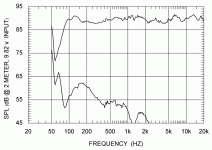Ok, so taking AJ's advice, I did a test with four records:
- Layla, Derek and the Dominos
- Ride the Lightning (Remastered), Metallica
- Book of Bad Decisions, Clutch
- Sunday at the Village Vanguard, Bill Evans
I started with the crossover set at 110, then 120, then 160 which is where it sounded best (the was no increment between 120 and 160). The results were like night and day. Warm, distinct, sounded better at a slightly louder volume. I found that I actually increased the level on my sub by about 3x. Where previously, bumping the sub up any more than about a qtr of the way resulted in just super heavy indistinct lows. Now with it up to about half way, the bass sounds amazing - heavy and thick, but separate in the mix. Literally, the bass lines in the songs sound better. In certain cases, the highs got a little muddy at higher volume - like on Clutch's latest - but Ride the Lightning and, specifically, Key to the Highway on Layla were awesome. The sweet spot for the volume was between 35 - 25 db whereas previously that's where it started to turn to mush. It actually sounded much better with the higher volume as opposed to softer. Since it's not an everyday thing, I'm not too concerned, but it would be great to listen at even higher levels (I'm thinking metal/punk - High on Fire, The Bronx, etc.) with that same sound quality. Over 25db though, it seemed to once again get sketchy although nowhere near as bad as before.
So, clearly the crossover made a huge difference, but can the case also be made for more power?
Thanks to everyone for the input. This was incredibly helpful - really really appreciate it.
Transferring the bass below 160 to the sub pretty much made the M1 3.9 driver a midrange. You stated the highs became muddy, a larger woofer won't help that. AJ continues to misstate your receiver's power. With only two channels you will get short bursts of 89.1 watts, with a continuous power of somewhere in the middle. That rating is if you were only listening to a 1kHz tone. Let's say your music was 50Hz to 15kHz, that's still quite a bit more bandwidth to produce than a 1kHz test tone. It also takes more power to produce that extra bandwidth.
Your speakers are 85dB efficient which takes a lot of power to play Metallica loud. A speaker at just 88dB can play roughly twice as loud with the same input signal. So I have no doubt the noise in the tweeters is your amp clipping.
To get what you really want it will take upgrading both speakers and amp, possibly. If you want to keep the receiver you need a more efficient speaker. And, a larger woofer will move more air and should go deeper in the bass region. But to get loud you need efficient speakers and ample clean power. Take a look at any Pro speaker, like for concerts, they are over 100dB. That's because you need efficiency to play loud. They don't use 85dB speakers. I had 85dB speakers and drove them with 250 clean power. Look at Avante Garde that Mike sells, 100+ because they have to be super efficient to be driven by small power tube amps of only a few watts. So if wanting to play loud with the power you have available and remain clean, you need more efficient speakers. My speakers are 94dB and I still drive them with 300 watts clean into 8 ohms. Music is dynamic, your power has to be clean and have reserve when called upon. Stuff like Metallica is calling on those reserves constantly.
I saw B&W has a new 6 series but I haven't seen specs or price yet. For what you're talking I'd suggest looking for a Klipsch. They are typically 95dB or higher. This would allow you to keep the receiver until you are able to upgrade it as well, if desired.
My answers to you were based on what you have now. I do prefer larger woofers if given the choice. For one, I don't prefer a sub with music.
I'm glad Bill Evans is on your list. Usually Rock music has had compression added somewhere along the way. And, the music contains distortion. So this type of music isn't going to sound as good as a decent Jazz recording no matter what system you have.
I just recently heard that Clutch album and thought it was good. I've got a couple of their earlier albums, one of them has Electric Worry. Have you heard Metallica, Hardwired to Self Destruct? Probably one of the best since Ride The Lightning IMO. I'm not a fan of the "black" album and I am one who likes In Justice.
A couple Rock albums that struck me as being better than average sound quality was the Three Days Grace album that contains Chalk Outline. My disc sounds good, however, streaming versions I've heard, not so good. And, a new release Our Mirage, Lifeline.


